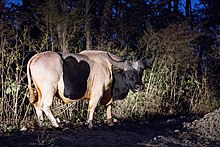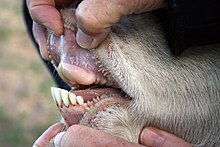Bovidae
The bovids (Bovidae) are a family of artiodactyl mammals that includes antelopes, goats, sheep and bulls, as well as other similar animals. All of them have in common a strictly herbivorous diet. In many, but not all, bovid species, both males and females have bony protrusions (horns) on their heads. Unlike deer antlers, bovine horns are permanent and unbranched. In general, these species do well in moderate and tropical climates.
The largest bovids can weigh close to a ton and have a height of two meters from their hooves to the withers (oxen, buffaloes, bison); on the other hand, the smallest can weigh only three kilos and not be bigger than a domestic cat (dicdics). Some of them are muscular specimens (like the bull), and others can be agile with long legs (like the gazelles). Most of the members of this family congregate in large groups with very complex social structures, but there are cases in which their behavior is not gregarious. Bovids cover a wide range of different climates and habitats; They can live in deserts, tundra and tropical forests.
They are all ruminants, and they also have one characteristic in common: their polycompartmental stomach. In the adult stage they have four gastric compartments, or stomachs, and are functionally divided into the reticulum, omasum, abomasum, and rumen. The different functions of each compartment cover the entire digestion process of the ingested vegetables, which may be fodder (grass) or agricultural products (straw, hay, alfalfa, etc.) in the case that they are animals. domestic. In the infant stages, bovids only have developed the abomasum and feed only on mother's milk; at this time they are not considered ruminants. At approximately three months of age, depending on the species, they usually already have their four stomachs working.
Most bovids are diurnal. Social activity and eating typically peak during sunrise and sunset. Bovids usually rest before dawn, during noon and at dusk. They have various methods of social organization and social behavior, which are classified into solitary and gregarious behavior. Bovids use different forms of vocal, olfactory, and tangible communication. Most species feed and ruminate alternately throughout the day. While small bovids forage in dense, enclosed habitats, larger species feed on high-fiber vegetation in open grasslands. Most bovids are polygynous. Mature bovids mate at least once a year, and smaller species may even mate twice. In some species, newborn bovids remain hidden from one week to two months, regularly nursing from their mothers; in other species, hatchlings are followers, accompanying their mothers, rather than tending to stay hidden.
Classification
According to Mammal Species of the World, the family Bovidae is made up of the following subfamilies:
- Family Bovidae
- Subfamily Aepycerotinae
- Subfamily Alcelaphinae
- Subfamily Antilopinae
- Subfamily Bovinae
- Subfamily Caprinae
- Subfamily Cephalophinae
- Subfamily Hippotraginae
- Subfamily Reduncinae
Cladogram
A possible bovid cladogram is represented below:[citation needed]
| Bovidae |
| ||||||||||||||||||||||||||||||||||||||||||||||||||||||
Evolution
Early and earlier Miocene
In the early Miocene, bovids began to diverge from cervids (deer) and giraffids. The first bovids, whose presence in Africa and Eurasia in the last part of the early Miocene (20 million years ago) has been confirmed, were small animals, somewhat similar to modern gazelles, and probably lived in forested environments. Eotragus, the earliest known bovid, weighed 18 kg (39.7 lb) and was about the same size as Thomson's gazelle. Early in their evolutionary history, bovids divided into two main clades: Boodontia (of Eurasian origin) and Aegodontia (of African origin). This early genetic divergence between Boodontia and Aegodontia has been attributed to the continental divide between these landmasses. When these continents rejoined, this barrier disappeared, and either group expanded into the other's territory. The Bovini and Tragelaphini tribes diverged in the early Miocene. Bovidae are known to have arrived in the Americas in the Pleistocene. crossing the Bering Land Bridge.
The current genera of Alcelaphinae appeared in the Pliocene. The extinct genus of Alcelaphinae Paramularius, which was about the same size as the gorge, is thought to have arisen in the Pliocene, but became extinct by the mid-Pleistocene. Several genera of Hippotraginae are known from the Pliocene and the Pleistocene. This subfamily appears to have diverged from the Alcelaphinae in the latter part of the early Miocene. The Bovinae are thought to have diverged from the rest of the Bovidae in the early Miocene. The Boselaphini became extinct in Africa in the early Pliocene; its last fossils were excavated in Langebaanweg (South Africa) and Lothagam (Kenya).
Middle Miocene
The middle Miocene marked the expansion of bovidae into China and the Indian subcontinent. According to Vrba, radiation of the subfamily Alcelaphinae began in the latter part of the middle Miocene. The Caprinae tribes probably diverged in the early middle Miocene. The Caprini arose in the middle Miocene, and appear to have been replaced by other bovids and cervids in Eurasia. The earliest fossils of the antilopines are from the middle Miocene, although studies show the subfamily existed as early as the early Miocene. Speciation occurred in the Antilopini tribe during the middle or late Miocene, mainly in Eurasia. The Neotragini tribe appears to have appeared in Africa in the late Miocene, and had become widespread by the Pliocene.
Late Miocene
By the late Miocene, around 10 million years ago, bovids diversified rapidly, leading to the creation of 70 new genera. This late Miocene radiation was partly due to many bovids adapting to more open, prairie The Aepycerotinae first appeared in the late Miocene, and no significant difference in the size of the primitive and modern impala has been observed. Fossils of ovibovines, a tribe of Caprinae, in Africa date back to the late Miocene. The earliest Hippotragine fossils date back to the late Miocene, and were excavated at sites such as Lothagam and the Awash Valley. The earliest African fossils of Reduncinae date back to 6-7 Million years ago. Reduncinae and Peleinae probably diverged in the mid from the Miocene.
Features
All bovids have a similar basic shape: a snout with a blunt end, one or more pairs of horns (usually present in males) immediately after the oval or pointed ears, a distinct neck and limbs, and a tail that varies in length and bushiness between species. Most bovids are sexually dimorphic, with males generally being larger as well as heavier than females. Sexual dimorphism is most prominent in medium- and large-sized bovids. All bovids have four toes on each foot: they walk on the middle two (the hooves), while the outer two (the spurs) are much smaller and rarely touch the ground.
Bovids show great variation in size: the gaur can weigh over 1,500 kg (3,306.9 lb), and stand 2.2 m (86.6 in) tall at the shoulder. The dwarf antelope, by contrast, is only 25 cm long and weighs at most 3 kg. The klipspringer, another small antelope, stands 45–60 cm at the shoulder and weighs only 10–20 kg.
The differences are in coat coloration, which ranges from pale white (as in the Arabian oryx) to black (as in the black wildebeest). However, only shades in between, such as brown and reddish-brown (as in the redunca), are commonly seen. In several species, females and young show light-colored fur, while males show pale fur. darkens with age.As in the wildebeest, the coat may be marked with prominent or faint stripes.In some species such as the addax, coat color may vary seasonally.Scent glands and oil glands are often present.
Some species, such as the gemsbok, sable antelope, and Grant's gazelle, are camouflaged with strongly disruptive facial markings that hide the highly recognizable eye. Many species, such as gazelles, can appear flat, and therefore blend against the background, by counter-shading. The outlines of many bovids are broken up by conspicuous coloration which helps to delay recognition by predators. However, all Hippotraginae (including gemsbok) have the body and face face pale with conspicuous markings. Zoologist Tim Caro describes this as difficult to explain, but since the species are diurnal, he suggests that the markings may function in communication. Highly contrasting leg coloration is only common in bovids, where, for example, the Bos, Ovis, bontebok and gemsbok have white stockings. Again, the most likely function is communication.
Except for a few domesticated forms, all male bovids have horns and, in many species, females do as well. The size and shape of horns vary widely, but the basic structure is a pair of simple unbranched bony protrusions, often spiral, twisted, or ridged in shape, each covered by a permanent keratin sheath. Although the horns occur in a single pair in almost all bovid species, there are exceptions such as the four-horned antelope and Jacob's sheep. The unique structure of the horns is the only unequivocal morphological feature of bovids that distinguishes them. distinguishes it from other foraging birds. There is a high correlation between the morphology of the horns and the fighting behavior of the individual. For example, long horns are intended for fighting and fencing, while curved horns are used for charging. Males with inward-facing horns are monogamous and solitary, while males with outward-facing horns tend to be polygynous. These results were independent of body size.
The development of male horns has been linked to sexual selection, the horns are small spikes in monogamous duikers and other small antelopes, whereas in polygamous they are large and elaborate (for example, in a spiral structure, as in the giant eland). Thus, to some extent, horns represent the degree of competition between males of a species. However, the presence of horns in females is probably due to natural selection. Female horns tend to be smaller than those of the males, and sometimes have a different shape. The horns of female bovids are thought to have evolved to defend themselves against predators or to express territoriality, since non-territorial females, which are capable of using crypsis to defend themselves against predators, typically do not have horns. Females possess horns in only half of the bovid genera, and the females of these genera are heavier than those of the rest. Females use their horns primarily for stabbing.
Anatomy
In bovids, the third and fourth metapodials are combined into the long metatarsus. The ulna and fibula are reduced and fused with the radius and tibia, respectively. The long scapulae are present, while the clavicles are absent. In ruminants, the stomach is composed of four chambers: the rumen (80%), the omasum, the reticulum, and the abomasum. Rumen ciliates and bacteria ferment the complex cellulose into simpler fatty acids, which are then absorbed through the rumen wall. Bovids have a long small intestine; the length of the small intestine in cattle is 29-49 m (95.1-160.8 ft). Body temperature fluctuates throughout the day; for example, in goats the temperature can change slightly from almost 37 degrees Celsius (98.6 °F) first thing in the morning to 40 degrees Celsius (104 °F) in the afternoon. Temperature is regulated by sweat in cattle, while goats use panting for the same. The right lung, consisting of four to five lobes, is about 1.5 times larger than the left, which has three lobes.
Contenido relacionado
Hemicellulose
Leptin
Progesterone







